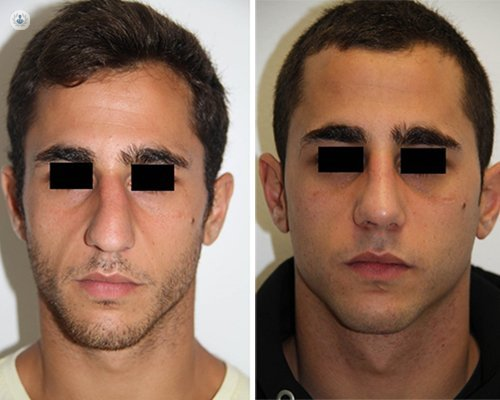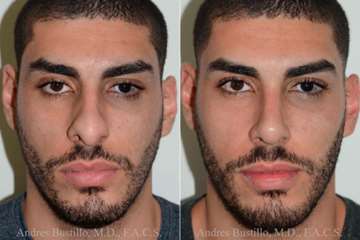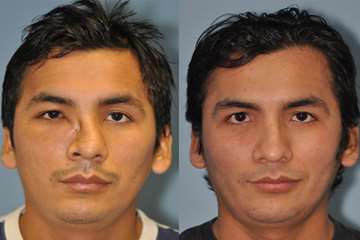(Nostril Symmetry Correction Surgery)
Comprehensive Article on Nasal Symmetry Surgery

Comprehensive Article on Nasal Symmetry Surgery (Nostril Symmetry Correction Surgery)
Introduction
Nasal symmetry surgery, also known as nostril symmetry correction surgery, is a cosmetic and corrective procedure aimed at improving the balance and alignment of the nostrils. Nostril symmetry is one of the key factors in the overall facial beauty and the harmony of the nose with other facial features. Asymmetry in the nostrils can be caused by genetic factors, physical trauma, or previous surgeries and may negatively impact a person’s appearance. The purpose of this article is to provide comprehensive information about nasal symmetry surgery, including reasons for undergoing the procedure, surgical methods, advantages and disadvantages, post-operative care, and expected results.
Reasons for Nasal Symmetry Surgery
Nostril asymmetry can result from various causes, and many individuals seek symmetry correction surgery to improve the appearance and function of their nose. Below are the main reasons for this type of surgery:
- Genetics and Natural Nose Structure
In some individuals, nasal asymmetry is present from birth due to natural growth variations. This asymmetry can occur because of uneven cartilage development or differences in the size and shape of the nostrils. In such cases, nostril symmetry correction can make the nose appear more harmonious and aesthetically pleasing. - Physical Trauma
Injuries and trauma to the nose, such as fractures from accidents or sports activities, can alter the shape of the nose and create nostril asymmetry. These injuries may result in fractured or displaced cartilage and bones, leading to uneven nostril appearance. - Previous Surgeries
In some cases, nostril asymmetry may arise after previous nasal surgeries, such as rhinoplasty. In this situation, the patient may be dissatisfied with the surgical outcome and seek corrective surgery to address the asymmetry. Revision rhinoplasty is performed to improve undesirable results from previous surgeries, ensuring the nostrils are symmetrical. - Functional Problems
Beyond aesthetic reasons, nostril asymmetry may cause functional issues. In some individuals, uneven nostrils can lead to obstruction of one airway, causing breathing difficulties. In such cases, nostril symmetry surgery not only enhances appearance but also helps improve breathing.
Surgical Methods for Nasal Symmetry Surgery
Several surgical methods are available for nostril symmetry correction, and depending on the patient’s needs and the nature of the issue, the surgeon will choose the most appropriate method. Below are the main surgical techniques used:
- Open Rhinoplasty
Open rhinoplasty is one of the most common methods used for nostril symmetry correction. In this approach, the surgeon makes a small incision in the columella (the area between the two nostrils) to access the internal structure of the nose. This method allows the surgeon to have a more detailed view of the cartilage and bones to make precise adjustments and improve nostril symmetry.
Open rhinoplasty is particularly suitable for patients with significant nostril asymmetry or those who require major structural changes. The surgeon can reshape the cartilage and adjust the nostrils for better proportion. However, this method usually involves a longer recovery period and may leave a small scar in the columella area. - Closed Rhinoplasty
In closed rhinoplasty, all incisions are made inside the nostrils, with no external cuts on the nose. This method is suitable for patients who need minor changes in nostril size or shape. One advantage of closed rhinoplasty is that it leaves no external scars, and the recovery period is generally shorter than with open rhinoplasty.
Closed rhinoplasty is ideal for cases where the asymmetry is minor, and significant structural changes are not required. However, because the surgeon’s view is more limited, it is not recommended for more complex surgeries. - Cartilage Grafting
In some cases, the surgeon may need to use cartilage grafts to create nostril symmetry. These grafts are typically taken from the patient’s ear or ribs and are used to reinforce or reshape the nasal cartilage. Cartilage grafting allows the surgeon to make more precise structural adjustments and achieve the desired results.
Advantages and Disadvantages of Nasal Symmetry Surgery
As with any surgery, nasal symmetry correction has its advantages and disadvantages, which patients should carefully consider before making a decision.
Advantages
- Improved Aesthetic Symmetry: One of the biggest advantages of this surgery is the enhancement of nasal symmetry and appearance. After the procedure, the nostrils will appear more balanced and in harmony with the rest of the face, contributing to an overall more attractive appearance.
- Increased Self-Confidence: Many individuals who were dissatisfied with their appearance due to nostril asymmetry feel more confident after the surgery. This change can lead to improved self-esteem and a better quality of life.
- Better Breathing: In some cases, the surgery can improve breathing function. If the nostril asymmetry has caused an airway obstruction, surgery can open up the airways and enhance breathing.
- Permanent Results: The results of nostril symmetry correction are typically permanent. Once the patient has fully recovered, they can enjoy the long-lasting effects of the surgery.
Disadvantages
- Long Recovery Period: One of the drawbacks of this surgery is the extended recovery time. After surgery, patients may experience swelling, bruising, and tenderness for several weeks. They may also need to rest and avoid physical activities for a period of time.
- Surgical Risks and Complications: As with any surgery, there are risks involved with nasal symmetry correction. Potential complications include infection, bleeding, wound healing issues, and dissatisfaction with the final results.
- Need for Revision Surgery: In some cases, the results of the surgery may not be entirely satisfactory, requiring revision surgery. This is more common in complex cases where significant changes are made.
Post-Operative Care for Nasal Symmetry Surgery
Post-surgery care plays a crucial role in ensuring a quicker recovery and achieving optimal results. Below are some key post-operative care guidelines following nasal symmetry surgery:
- Using Cold Compresses: After surgery, applying cold compresses can help reduce swelling and bruising. This should be done regularly during the first few days to aid in a faster recovery.
- Avoiding Strenuous Activities: Patients should avoid heavy physical activities and strenuous exercise, as these can increase the risk of bleeding or swelling. It is recommended to refrain from such activities for a few weeks post-surgery.
- Sleeping with Head Elevated: Keeping the head elevated while sleeping helps reduce swelling and promotes faster healing. Using a few pillows to elevate the head during the recovery period is highly recommended.
- Regular Follow-Up with the Surgeon: Regular follow-up appointments with the surgeon are essential to monitor the healing process. If any complications arise, immediate action can be taken to address them.
Results and Expectations
The final results of nasal symmetry surgery usually become fully apparent after several weeks. During this period, swelling and bruising gradually subside, and the final shape of the nostrils emerges. Patients should maintain realistic expectations and understand that full recovery takes time. However, after complete healing, most patients are satisfied with the improved symmetry and aesthetic appearance of their nose.
Conclusion
Nasal symmetry correction surgery is an important cosmetic and corrective procedure that enhances the appearance and balance of the nose. This surgery is suitable for individuals who are dissatisfied with the asymmetry of their nostrils or have breathing issues. Choosing a skilled and experienced surgeon and following the recommended post-operative care is crucial to achieving the best and most successful results.



comment